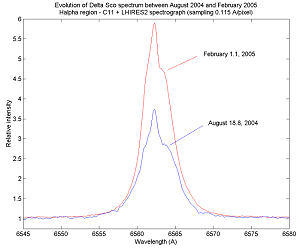
Spectroscopic survey of COROT Be stars
The spectroscopic Be stars Atlas A
Ha survey of Be type stars |

Spectroscopic
survey of COROT Be stars

Be
stars in Messier 45
Delta Sco increase activity in 2005...
Click
on the image below for enlarge the graph
and show the Equivalent Width evolution

Outburst of
Delta Scorpius
See also:
http://www.konkoly.hu/cgi-bin/IBVS?5026
http://simbad.u-strasbg.fr/bib/IBVS/5012-1.html
Time series observations 2004 sessions
2001 sessions |
The Be stars are defined to be rapidly rotating O, B, A-type stars of luminosity classes III-V which Balmer emission lines. Sometimes the line profiles of helium and iron also appear in emission. Many B stars show these characteristics, but the Be stars correspond only to the class of non-supergiants (classes III to V). Approximately 10% of the non-supergiant B-type stars present the characteristics of the Be stars. The majority of the Be stars belong to the spectral classes B0 to B7. 5% of Be are of spectral type O8-O9.5 and a small percentage (1%) belongs to the spectral type A0 or A1. A characteristic of the Be stars comes from the variability of aspect of the hydrogen lines (and sometimes, helium and iron). Stars can on a cycle of a few years show lines in strong emission, usually completely absent (confused with the continuum) or in absorption as in a normal star. The frequency of the variations of the profile lines covers a very broad range since some Be stars can show certain line-profile changes in a few hours or minutes whereas others can remain stable during years. Sometimes several cycles of variations with very different periods can be superimposed. The emission features themselves have a great variety of profiles. A typical situation is the shell configuration in which a narrow and deep absorption line is in the center of a broad emission line. Some time photospheric absorption line wings is visible on both sides of the emission line profile. It is probable that the majority of the Be stars present a "shell" phase to one moment of their life. The origin of the emission of the
lines is related to the presence of a disk and/or a flattened envelope
in fast rotation. The circumstellar material rotational velocity,
that can exceed 300 km/s, which explains why the majority of these
stars show very widened lines (Doppler broadening). It should be
remembered that what is observed is an apparent speed, which
differs from true the disk velocity V because of tilt of the axis of rotation
i from the observer line of sight. Measured speed is thus
V.sin i, the projected rotational velocity, and not V.
If a Be star shows a low projected rotational velocity, it is most
of the time because i has a low value (polar-on view of
the star). If the material in the disk is sufficiently optically
thick, we observe a narrow absorption lines from the part
of the disk with is projected in front of the underlying star (for
this situation, the material is moving essentially at right angle
to the line of sight, so were is no Doppler broadening). This explains
the Be-shell subclass.
The rapidly-rotation star with equatorial gazeous shell produces different line profiles (rigth) in function of the polar inclinaison (left). Up to down: 42 And (polar-on configuration), 4 Her, 1 Del, and 88 He (equatorial-on configuration). The last profile is a typical shell type: the star show emission wings and a sharp absorption core. Rotational model from A. Sletteback (Space Sci. Rev., 23, 541, 1979). But note that for several Be stars the shell spectrum comes and goes frequently and it is difficult to understand why the Be phenomenon is so episodic on the basis of this simple rotational model. Other mechanism are presents... It is generally assumed that it is the high spin velocity of the star which partly explains the presence of these circumstellar material, the force of gravity hardly compensating for the centrifugal force at the equator. However there is no absolute explanation to origin and the significant variations of the spectral characteristics of the Be stars. Concerning the abrupt changes in the spectral line profiles, on time scales of a few hours to a few days, it is mentioned the presence of outbursts, like strong solar eruptions, and it seems that strong magnetic fields induced by dynamo action, large stellar wind, non-radial vibration or spots on the stellar surface plays a key role. Moreover, the Be stars often have a close companion, which must play a role because of phenomenon of mass transfer between the two components and can explain medium term variability. Clearly, Be stars are now classified as active hot star. But the exact mechanism explaining the short, medium and long term variations still remain to be found. The origin of the disk and the type of rotational velocity law of this disk is also not yet completely clear. It is not a surprise to see that numerous Be stars are variable stars of small amplitude (0.01 to 0.1 mag.). In a recent article A.M Hubert and M. Floquet, Meudon Observatory (Investigation of the variability of bright Be stars using Hipparcos photometry, Astron. Astrophys. 335, 565-572 (1998) says: The search for a link between spectroscopic and photometric variations, crucial for testing dynamic models of circumstellar matter, strongly suffers from lack of spectroscopic data available for last decades on Be stars. Carry out photometric and spectrometric observations is a very feasible spot for the astronomers amateurs with the tools available today! At the present time, we don't know how a B star can become a Be or a Be-shell star and we don't know if all the B stars will become, one day, Be stars. All this explains the interest to study these peculiar stars. This is a very dynamic subject of research in present time and observations are urged for constraining and consolidating numerical models of this mysterious objects.
|
The study of the Be stars is a long tradition for French amateurs, since a program was undertaken in 1992 with the 60-centimeter telescope at Pic du Midi (T60) by Alain Klotz, Valerie Desnoux, Daniel Bardin and some other volunteers. This pioneer work clearly showed an example of a research program accessible to the amateurs and useful for the professionals. My own observations of the Be stars
correspond to a long-term monitoring of the H-alpha emission-line
(and some time of the He I line at 6678 A), extending over several
years. The aim is to collect a large amount of homogeneous data
of this spectral region. The main telescopes used are a Celestron
11 (0.28m aperture F/10, noted T280 in the data base) and a Takahashi
CN-212 (0.21m aperture F/D=3.5, referenced T212 in the
atlas data). I have also used 190-millimeter Lichtenknecker flat-field
camera at F/D=4 (referenced T190), a Takahashi FS-128 refractor
(128-mm aperture, referenced R128), an AstroPhysics StarFire
120 refractor (120-mm aperture, referenced R120) and a Takahashi FSQ-106 refractor
(106-millimeters aperture, referenced R106). The CCD camera are
Audine models and
the CCD are Kodak KAF-1602E and KAF-0402ME. The pixel size is of 9 microns.
The actual more resolving spectrograph used is LHIRES2
(R=17 000, spectral sampling of 0.115 A/pixel). I used also spectrograph having a resolution power of about R=
7 000 (one pixel corresponds to 0.3805 A/pixel at H-alpha
region) and R=10 000 (0.2293 A/pixel
- since June 2003). I have merged in my database unpublished observations made at the T60 between 1992 and 1997 (with authorization) in order to be used for a very useful long term survey evolution. Some spectra are from Stephane and Didier Morata who observe with a 300-mm telescope near Martigue (France) (see: http://perso.wanadoo.fr/sdmorata/). The resolution of these spectra is slightly weaker than my actual spectrograph. The resolution power is estimateded to 2.5 A and the reciprocal spectra sampling is 1.05 A/pixel. Morata's spectra are identified by the SDM indicateur.
|